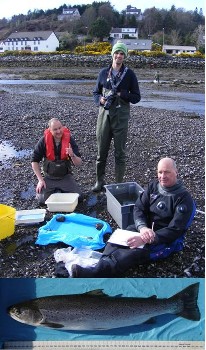Sea trout recaptured for fourth time in Loch Gairloch
Posted: Tuesday 17 April, 2012 @ 15:37:04

The WRFT Wild Trout (sea trout and brown trout) Report for 2011 can be found on the downloads page of the WRFT website or by clicking here. This illustrated report presents the results of trout sampling including the sweep netting programme in coastal waters around Wester Ross (partly supported by the Scottish Government via RAFTS) and sampling in freshwater, and provides information about the growth and ages of trout from scale reading. Data describing levels of infection by sea lice are presented.
If you have any comments on the report please contact the WRFT Biologists at info@wrft.org.uk.
The WRFT 2012 sea trout monitoring programme is underway. After an initial unsuccessful netting session in March, the WRFT sea trout sampling team had more success with the sweep net on 11th April in Loch Gairloch. A mixed sample of 41 overwintered sea trout and overwintered finnock was taken in front of the WRFT office in the Harbour Centre. Most of the fish were rather lean as expected early in the season but in otherwise good condition with relatively few Lepeophtheirus salmonis sea lice (0-35 lice per fish; average 6.5). Some of the fish were heavily infected by the trematode fluke, Cryptocotyle lingua, with up to 20 ‘black spots’ per cm2 of caudal fin (as described in the WRFT Review May 2011).
One of the fish was recognised as a recaptured trout. This fish (shown right and ‘Fish B’ in the 2011 report) was initially taken on 18th March 2011 (350mm, 416g), and thereafter on 14th June 2011(392mm, 622g) and 27th September 2011 in browner spawning colouration (425mm, 828g). On 11th April 2012, the fish was silvery again and had grown to 465mm in length and 1060g in weight.
This is the second sea trout known to have doubled its weight in Loch Gairloch within a year. At the time of writing, there are reports of sandeels in coastal waters (inside rod caught Pollack) and flocks of gulls (Kittiwakes) have been seen feeding nearby. The salmon and sea trout smolt migration is currently underway; future prospects for local fisheries will be better if there is plenty of food for them as they reach the sea.